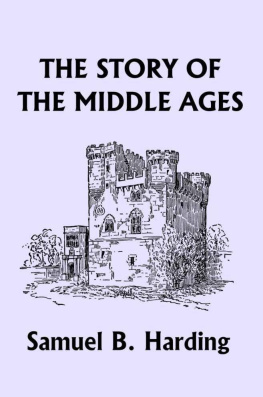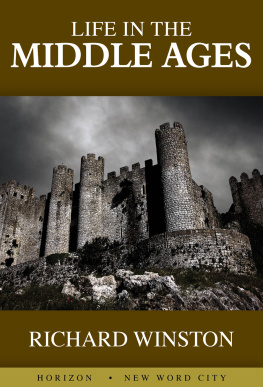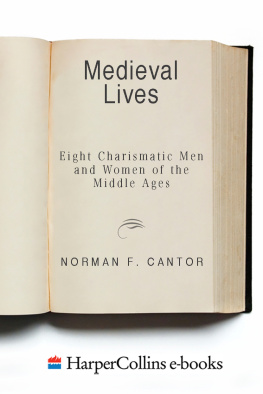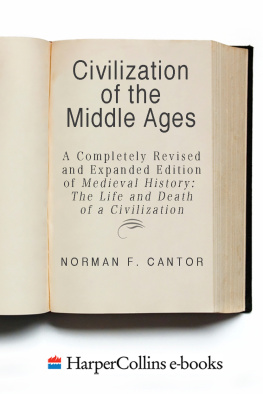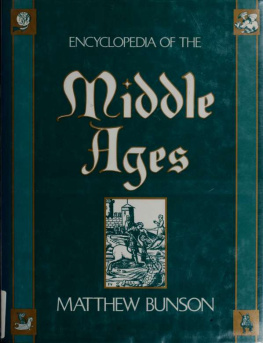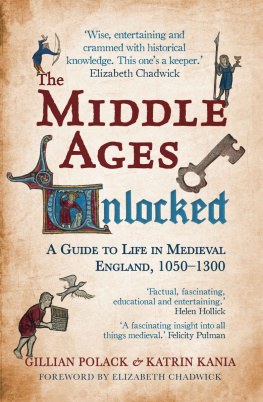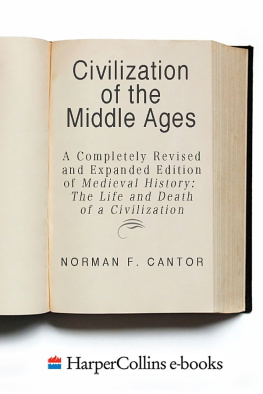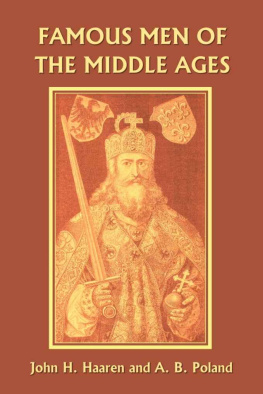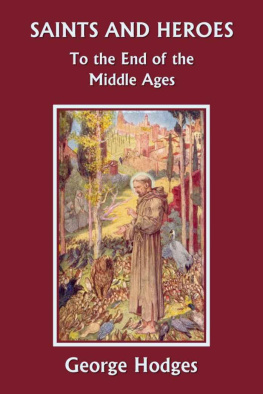Samuel B. Harding - The Story of the Middle Ages
Here you can read online Samuel B. Harding - The Story of the Middle Ages full text of the book (entire story) in english for free. Download pdf and epub, get meaning, cover and reviews about this ebook. year: 2006, publisher: Yesterdays Classics, genre: History. Description of the work, (preface) as well as reviews are available. Best literature library LitArk.com created for fans of good reading and offers a wide selection of genres:
Romance novel
Science fiction
Adventure
Detective
Science
History
Home and family
Prose
Art
Politics
Computer
Non-fiction
Religion
Business
Children
Humor
Choose a favorite category and find really read worthwhile books. Enjoy immersion in the world of imagination, feel the emotions of the characters or learn something new for yourself, make an fascinating discovery.
- Book:The Story of the Middle Ages
- Author:
- Publisher:Yesterdays Classics
- Genre:
- Year:2006
- Rating:3 / 5
- Favourites:Add to favourites
- Your mark:
- 60
- 1
- 2
- 3
- 4
- 5
The Story of the Middle Ages: summary, description and annotation
We offer to read an annotation, description, summary or preface (depends on what the author of the book "The Story of the Middle Ages" wrote himself). If you haven't found the necessary information about the book — write in the comments, we will try to find it.
The Story of the Middle Ages — read online for free the complete book (whole text) full work
Below is the text of the book, divided by pages. System saving the place of the last page read, allows you to conveniently read the book "The Story of the Middle Ages" online for free, without having to search again every time where you left off. Put a bookmark, and you can go to the page where you finished reading at any time.
Font size:
Interval:
Bookmark:
All rights reserved. No part of this book may be reproduced or retransmitted in any form or by any means without the written permission of the publisher.
This edition, first published in 2010 by Yesterday's Classics, an imprint of Yesterday's Classics, LLC, is an unabridged republication of the work originally published by Scott, Foresman & Co. in 1906. This title is available in a print edition (ISBN 978-1-59915-157-1).
Yesterday's Classics republishes classic books for children from the golden age of children's literature, the era from 1880 to 1920. Many of our titles are offered in high-quality paperback editions, with text cast in modern easy-to-read type for today's readers. The illustrations from the original volumes are included except in those few cases where the quality of the original images is too low to make their reproduction feasible. Unless specified otherwise, color illustrations in the original volumes are rendered in black and white in our print editions.
The point of view from which this book is written is perhaps sufficiently set forth in the introductory chapter, but it may fittingly call for an additional word in this place. It is, namely, the point of view of one who believes that the child about to undertake the formal study of American history in the seventh and eight grades of our schools, needs first a preliminary sketch of the history of earlier times,especially of the Middle Ages,in order that our own history may appear in its true perspective and setting.
In attempting to make intelligible to children the institutions and events of the Middle Ages, the author is aware of the magnitude of the task which he has essayed. He is, however, firmly of the opinion that the difficulty arises frequently not so much from an inability on the part of the child to grasp the essential ideas underlying medieval relations, as from the lack of a clear understanding of these on the part of the narrator himself, and the need of finding familiar non-technical terms of definition. Whether the difficulty has been entirely surmounted in this work can only be determined by the test of use; but at least no pains have been spared in the effort. The interest of the book, no doubt, might have been enhanced had the author wished to give stories, instead of "the story" of the Middle Ages. Detached episodes, striking figures, romantic tales, exist in plenty to rivet the childs attention and fire his fancy; but it has been no part of the plan of this work to draw attention to particular persons and events at the expense of the whole. "Somehow," writes Walter Bagehot of historical reading for children, "the whole comes in boyhood; the details later and in manhood. The wonderful series going far back to the times of the old patriarchs with their flocks and herds, the keen-eyed Greek, the stately Roman, the watching Jew, the uncouth Goth, the horrid Hun, the settled picture of the unchanging East, the restless shifting of the rapid West, the rise of the cold and classical civilization, its fall, the rough impetuous Middle Ages, the vague warm picture of ourselves and home,when did we learn these? Not yesterday nor to-day; but long ago in the first dawn of reason, in the original flow of fancy. What we learn afterwards are but the accurate littlenesses of the great topic, the dates and tedious facts. Those who begin late learn only these; but the happy first feel the mystic associations and the progress of the whole."
BLOOMINGTON, INDIANA
July, 1901
B OYS and girlsand grown folks alsooften turn first to the last chapter of a book, before reading it, to see how it "ends." At times this is a good idea; for when we know the end of a story, we can often better understand it as it is told. This then is what we will do in this book. We will first see what the "end" of the story of the Middle Ages is; then, as we read, we shall better understand how that end was brought about.
When Columbus in the year 1492 returned from his voyage of discovery, a keen rivalry began among the Old World nations for the possession of the New World. Expedition followed expedition; Spaniards, Portuguese, French, English, and later the Dutch and Swedes,all began to strive with one another for the wealth and dominion of the new-found lands; and American historyour own historybegins.
But who were these Spaniards and Portuguese, these Englishmen and Frenchmen, these Dutchmen and Swedes? In the old days when the might and power of Rome ruled over the world, we hear nothing of them. Whence had they come? Were they entirely new peoples who had had no part in the old world of the Greeks and Romans? Were they the descendants of the old peoples over whom the Emperors had ruled from the city of the Seven Hills? Or did they arise by a mingling of the old and the new? Then, if they were the result of a mingling, where had the new races dwelt during the long years that Rome was spreading her empire over the known world? When and how had the mingling taken place? What, too, had become of
"The Glory that was Greece, the grandeur that was Rome"?
Why was America not discovered and settled before? What were the customs, the ideas, the institutions which these peoples brought with them when they settled here? In short, what had been the history and what was the condition of the nations which, after 1492, began the struggle for the mastery of the New World?
To such questions it is the aim of this book to give an answer. It will try to show how the power of Rome fell before the attacks of German barbarians, and how, in the long course of the Middle Ages, new peoples, new states, a new civilization, arose on the ruins of the old.
At the beginning of the period Rome was old and worn out with misgovernment and evil living. But planted in this dying Rome there was the new and vigorous Christian Church which was to draw up into itself all that was best and strongest of the old world. The Germans were rude and uncivilized, but they were strong in mind and body, and possessed some ideas about government, women, and the family which were better than the ideas of the Romans on these subjects.
When the Germans conquered the Romans, and settled within the bounds of the Empire, it might well have seemed that the end of the world was come. Cities were plundered and destroyed; priceless works of art were dashed to pieces; and the inhabitants of many lands were slain or enslaved. For nearly a thousand years Europe did not entirely recover from the shock; and the period which immediately follows the invasions of the barbarians is so dreary and sad that historians have called it "the Dark Ages."
But what was best in the old Greek and Roman civilization did not wholly perish. The Christian Church, too, grew steadily stronger, and sought to soften and civilize the rude Germans. The Germans, in turn, did not lose their vigor or their good ideas. At last from the combination of all these elements a new civilization arose,stronger, better, and capable of higher development than the old,and the Middle Ages were past. Then and only then couldand didthe new nations, which meanwhile had slowly been forming, set out on their careers of discovery and exploration which have made our New World possible.
So, we may say, the Middle Ages were the period when Europe became Europe, and made ready to found new Europes in America, in Australia, and in Africa. It was the growing-time for all the great harvest which has come since that time.
Font size:
Interval:
Bookmark:
Similar books «The Story of the Middle Ages»
Look at similar books to The Story of the Middle Ages. We have selected literature similar in name and meaning in the hope of providing readers with more options to find new, interesting, not yet read works.
Discussion, reviews of the book The Story of the Middle Ages and just readers' own opinions. Leave your comments, write what you think about the work, its meaning or the main characters. Specify what exactly you liked and what you didn't like, and why you think so.

